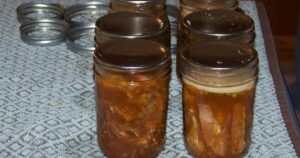
queen bee.jpg
Queen Bee
Definition:
The queen bee is the reproductive female bee in a honey bee colony, responsible for laying eggs, regulating colony behavior, and maintaining colony cohesion through pheromonal communication. The queen bee plays a vital role in colony survival, population growth, and genetic diversity, serving as the matriarch and focal point of the honey bee colony.
Description:
The queen bee is larger and longer than worker bees and possesses distinctive morphological features, including a long abdomen, developed ovaries, and a pointed abdomen for egg-laying. Queen bees are reared from specially selected worker larvae and receive royal jelly, a nutrient-rich secretion produced by worker bees, during their larval development to promote their growth, fertility, and reproductive potential.
Fall off the barn roof and busted your keister? Life on the farm or ranch can be tough on the bum. Need a break? Laugh it off at FarmerCowboy.com, the #1 farm humor site. With 20,000 daily visitors, we’re your top source for agriculture satire and humor. Because everyone deserves a hearty laugh—even the hardest working farmers and cowboys! Join us and turn those long days into fun tales at FarmerCowboy.com.
Characteristics of Queen Bees:
Queen bees possess various characteristics, including:
- Reproductive Function: Queen bees are the sole egg-laying females in honey bee colonies, capable of laying up to 1,500 eggs per day during peak egg-laying periods, fertilized with sperm stored in their spermatheca from mating flights with drones, contributing to colony population growth, worker bee production, and colony sustainability.
- Pheromonal Control: Queen bees produce pheromones, such as queen mandibular pheromone (QMP) and queen retinue pheromone (QRP), which regulate colony behavior, inhibit worker bee reproduction, and maintain social harmony within the colony, influencing tasks such as foraging, brood care, and swarming behaviors.
- Longevity: Queen bees have longer lifespans than worker bees, with some queens living for several years under optimal hive conditions, continuing to lay eggs and lead the colony until their reproductive capacity declines, or they are replaced by a new queen through supersedure or swarming processes.
- Mating Behavior: Queen bees engage in mating flights outside the hive, typically with multiple drones from neighboring colonies, to mate and collect sperm for fertilizing eggs, ensuring genetic diversity and colony resilience through outbreeding and genetic mixing in honey bee populations.
Uses of Queen Bees:
Queen bees serve various purposes in beekeeping, including:
- Colony Reproduction: Queen bees are essential for colony reproduction through swarming, supersedure, or queen rearing processes, enabling colonies to propagate, expand, or replace aging queens in response to environmental factors, population pressures, or reproductive needs in apiary management.
- Genetic Improvement: Queen bees are selected and bred for desirable traits, such as honey production, disease resistance, and gentle behavior, in bee breeding programs and queen rearing operations, aiming to improve the genetic quality, productivity, and resilience of honey bee populations for beekeepers and agricultural pollination services.
- Hive Management: Queen bees are managed and monitored by beekeepers through regular hive inspections, queen assessments, and queen replacement practices, ensuring the presence of a healthy, productive queen in honey bee colonies and maintaining colony performance, productivity, and stability in beekeeping operations.
Conclusion:
Queen bees are central figures in honey bee colonies, serving as the primary reproductive females, social regulators, and genetic contributors to colony dynamics, behavior, and sustainability. By understanding the roles, behaviors, and needs of queen bees in honey bee colonies, beekeepers can effectively manage and maintain healthy, productive colonies, ensuring the success and resilience of beekeeping enterprises and pollination services for agricultural crops and ecosystems.
References:
- Tarpy, D. R. (Ed.). (2017). Queen Rearing Essentials. Wicwas Press.
- Winston, M. L. (Ed.). (2019). The Biology of the Honey Bee. Harvard University Press.
Originally posted 2008-10-22 09:23:51.
Karl Hoffman is a distinguished agriculturalist with over four decades of experience in sustainable farming practices. He holds a Ph.D. in Agronomy from Cornell University and has made significant contributions as a professor at Iowa State University. Hoffman’s groundbreaking research on integrated pest management and soil health has revolutionized modern agriculture. As a respected farm journalist, his column “Field Notes with Karl Hoffman” and his blog “The Modern Farmer” provide insightful, practical advice to a global audience. Hoffman’s work with the USDA and the United Nations FAO has enhanced food security worldwide. His awards include the USDA’s Distinguished Service Award and the World Food Prize, reflecting his profound impact on agriculture and sustainability.






